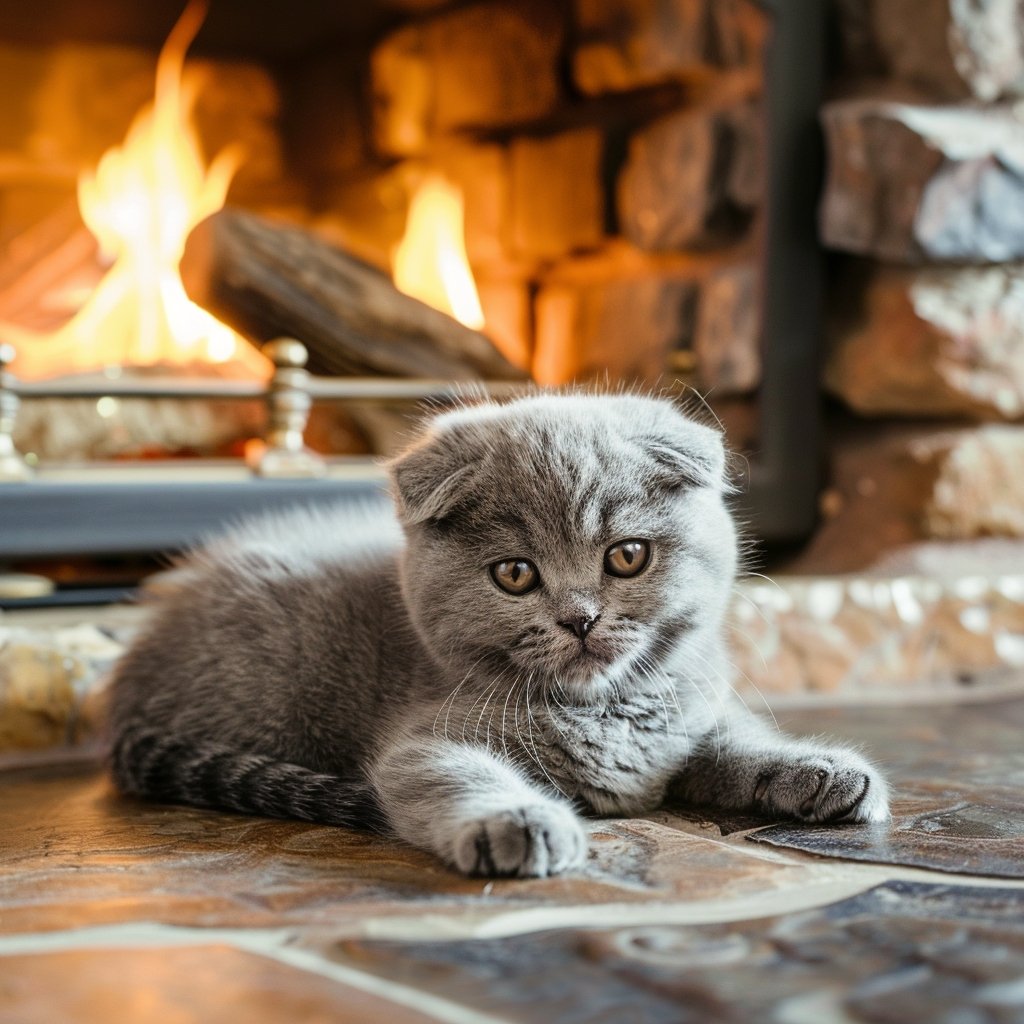Feline parvovirus, also known as feline panleukopenia, is a highly contagious disease that can pose a serious threat to your cat’s health, especially if they’re young or unvaccinated. Recognizing the symptoms early can make a significant difference in your cat’s recovery and well-being. This viral infection affects the gastrointestinal tract and can lead to severe complications, ranging from dehydration to a weakened immune system.
If you notice your cat exhibiting signs like vomiting, diarrhea, or a sudden drop in energy, it’s crucial to act swiftly.
Early diagnosis and treatment not only improve the prognosis, but also minimize the risk of spreading the virus to other felines.
This viral infection affects the gastrointestinal tract and can lead to severe complications, ranging from dehydration to a weakened immune system.

If you notice your cat exhibiting signs like vomiting, diarrhea, or a sudden drop in energy, it’s crucial to act swiftly.
Early diagnosis and treatment not only improve the prognosis, but also minimize the risk of spreading the virus to other felines.
If you notice your cat exhibiting signs like vomiting, diarrhea, or a sudden drop in energy, it’s crucial to act swiftly.
Early diagnosis and treatment not only improve the prognosis, but also minimize the risk of spreading the virus to other felines.
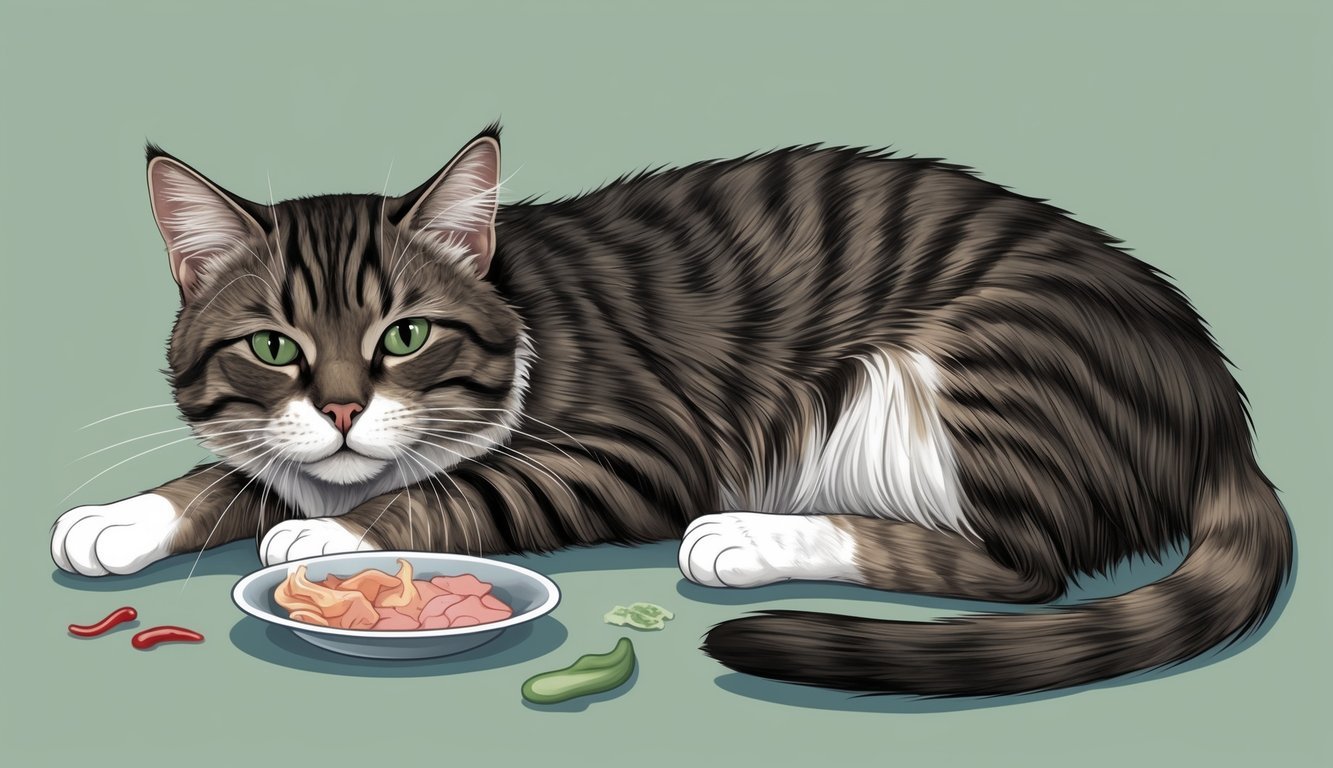
If you notice your cat exhibiting signs like vomiting, diarrhea, or a sudden drop in energy, it’s crucial to act swiftly.
Early diagnosis and treatment not only improve the prognosis, but also minimize the risk of spreading the virus to other felines.
If you notice your cat exhibiting signs like vomiting, diarrhea, or a sudden drop in energy, it’s crucial to act swiftly.
Early diagnosis and treatment not only improve the prognosis, but also minimize the risk of spreading the virus to other felines.
If you notice your cat exhibiting signs like vomiting, diarrhea, or a sudden drop in energy, it’s crucial to act swiftly.
Early diagnosis and treatment not only improve the prognosis, but also minimize the risk of spreading the virus to other felines.
If you notice your cat exhibiting signs like vomiting, diarrhea, or a sudden drop in energy, it’s crucial to act swiftly.
Early diagnosis and treatment not only improve the prognosis, but also minimize the risk of spreading the virus to other felines.
If you notice your cat exhibiting signs like vomiting, diarrhea, or a sudden drop in energy, it’s crucial to act swiftly.
Early diagnosis and treatment not only improve the prognosis, but also minimize the risk of spreading the virus to other felines.
If you notice your cat exhibiting signs like vomiting, diarrhea, or a sudden drop in energy, it’s crucial to act swiftly.
Early diagnosis and treatment not only improve the prognosis, but also minimize the risk of spreading the virus to other felines.
If you notice your cat exhibiting signs like vomiting, diarrhea, or a sudden drop in energy, it’s crucial to act swiftly.
Early diagnosis and treatment not only improve the prognosis, but also minimize the risk of spreading the virus to other felines.
If you notice your cat exhibiting signs like vomiting, diarrhea, or a sudden drop in energy, it’s crucial to act swiftly.
Early diagnosis and treatment not only improve the prognosis, but also minimize the risk of spreading the virus to other felines.
If you notice your cat exhibiting signs like vomiting, diarrhea, or a sudden drop in energy, it’s crucial to act swiftly.
Early diagnosis and treatment not only improve the prognosis, but also minimize the risk of spreading the virus to other felines.
In addition to being aware of the symptoms, knowing how to prevent parvo through vaccination and maintaining hygiene is essential in keeping your cat healthy.
By staying informed, you can protect your cat from this dangerous virus and ensure they live a happy, healthy life.
Key Takeaways
- Recognizing early symptoms of parvo can enhance your cat’s recovery.
- Vaccination is key to preventing the spread of feline panleukopenia virus.
- Prompt veterinary care is vital for managing infection risks and supporting recovery.
Understanding Parvo in Cats
Feline parvovirus, commonly known as feline panleukopenia or feline distemper, is a serious infectious disease that affects your cat’s health.
Understanding its causes and how it spreads can help you better protect your feline friend.
What Is Feline Parvovirus?
Feline parvovirus is a highly contagious virus that targets rapidly dividing cells, primarily those in the gastrointestinal tract.
This virus can lead to severe illness or even death, especially in young kittens or unvaccinated cats.
Symptoms of feline parvovirus include vomiting, diarrhea, lethargy, and fever.
Infected cats may also experience decreased appetite and dehydration.
It’s crucial to recognize these symptoms early and consult a veterinarian for swift action.
The Causes of Feline Parvo
Feline parvovirus infections occur primarily in unvaccinated cats and kittens.
The virus is stable and can survive in the environment for extended periods, making it easy for your cat to become exposed.
Cats that come into contact with infected animals or contaminated surfaces are at risk.
High-density settings, like catteries or shelters, often see higher infection rates due to close contact among cats.
To mitigate risks, ensure your cat is vaccinated according to your vet’s recommendations.
How Feline Parvo Spreads
Feline parvovirus spreads primarily through direct contact with infected cats or contaminated objects.
This includes shared food and water bowls, litter boxes, and even clothing or hands that have been near infected animals.
The virus can be shed in feces, and just a small amount can lead to new infections.
It’s important to restrict your cat’s exposure to unfamiliar animals and maintain a clean environment to reduce the chances of infection.
Regular veterinary check-ups and timely vaccinations are vital in keeping your cat safe from this perilous disease.
Symptoms of Parvo in Cats
Recognizing the symptoms of parvovirus in cats is crucial for prompt care.
The signs can be severe and vary between individual cats, especially in young kittens.
Here’s what to look out for.
Gastrointestinal Signs
Gastrointestinal symptoms are among the first indicators you may notice.
Vomiting is often one of the most prominent signs.
This can occur multiple times a day and might be accompanied by unusual odors.
Diarrhea is another key symptom, typically characterized by loose, watery stools.
You may find that the diarrhea is often bloody, which can signify a more severe infection.
Additionally, your cat may also show a reduced appetite, leading to weight loss over time.
Look for changes in litter box habits, as these can provide important clues about your cat’s health.
Physical and Behavioral Changes
You might observe noticeable changes in your cat’s behavior and physical condition.
Lethargy is common; your cat may seem uninterested in play or may prefer to stay in their favorite resting spot.
Depression can also manifest through a lack of responsiveness to familiar stimuli, such as your voice or touch.
Their coat may appear dull and unkempt, showing signs of neglect in grooming.
If you notice any of these changes, it’s essential to contact your veterinarian for further assessment.
Dehydration and Complications
Dehydration is a significant concern associated with parvovirus.
Because vomiting and diarrhea lead to substantial fluid loss, your cat may develop symptoms like sunken eyes, dry gums, and a decrease in skin elasticity.
You can perform a simple test at home by gently pinching the skin at the back of the neck.
If it doesn’t return to its normal position quickly, dehydration may be a problem.
Severe dehydration can lead to more serious complications, including shock and organ failure.
Monitoring these symptoms closely is vital for your cat’s recovery.
Diagnosis of Feline Parvo
Diagnosing feline parvovirus, or feline panleukopenia, involves a thorough clinical examination and specific laboratory tests.
These steps are crucial for accurate identification and prompt treatment to protect your cat’s health.
Clinical Examination
During a clinical examination, the veterinarian will look for several telltale signs.
You might notice symptoms like fever, lethargy, and vomiting in your cat.
The vet will also assess your cat’s physical condition, checking for dehydration and abdominal pain.
A notable finding could be a significant drop in the white blood cell count, which is common in cats suffering from this virus.
The combination of these clinical signs often raises suspicion of feline parvo, prompting further testing.
Laboratory Tests
Laboratory tests are essential for confirming the diagnosis.
One common method is a blood test to evaluate your cat’s overall health and specifically look for a low white blood cell count.
Another key test is a fecal test, where a sample of your cat’s feces is analyzed for the presence of the virus.
In some cases, a PCR test can be performed to detect the virus’s DNA, offering more definitive results.
These tests allow your veterinarian to understand the severity of the infection and determine the best course of action for treatment.
Treating Cat Parvo
When your cat is diagnosed with parvovirus, prompt and effective treatment is crucial.
The treatment primarily focuses on providing supportive care, managing symptoms, and preventing secondary infections.
Supportive Care Essentials
The first step in treating feline parvovirus is supportive care.
This involves ensuring your cat stays hydrated, as severe vomiting and diarrhea can lead to dehydration.
You may need to administer intravenous fluids if your cat is unable to drink enough water on its own.
A balanced electrolyte solution can help restore vital nutrients.
Additionally, it’s important to monitor your cat’s food intake and provide easily digestible foods.
Small, frequent meals may encourage eating.
Always consult your veterinarian about any dietary changes.
Medications and Antibiotics
Medications play a significant role in managing parvovirus symptoms.
Your vet may prescribe anti-nausea medications to control vomiting.
If your cat develops secondary bacterial infections—common with parvo—antibiotics may be necessary.
Even if your cat has a good appetite, it’s still important to follow your vet’s recommendations.
They may also suggest medications to ease abdominal pain.
Knowing the right medications and dosages can significantly improve your cat’s chances of recovery.
Hospitalization and Isolation
In severe cases, hospitalization may be required.
This allows for round-the-clock monitoring and more intensive treatment.
Keeping your cat isolated during recovery is vital to prevent the spread of the virus to other pets.
Veterinarians may use specialized equipment to provide a safe and sterile environment.
Isolation minimizes stress for your cat and helps ensure that they get the care they need in a quiet setting.
Your vet will let you know when it’s safe for your cat to return home.
Prognosis and Recovery
When dealing with parvo in cats, the prognosis can vary significantly based on several factors.
Early detection and prompt veterinary care greatly improve your cat’s chances of recovery.
The mortality rate for untreated feline parvovirus is unfortunately high, especially in kittens.
If your cat is showing severe symptoms, immediate action is crucial.
Once diagnosed, treatment typically involves supportive care, including fluids and medications to control vomiting and diarrhea.
This helps your cat’s immune system fight off the virus more effectively.
Be aware that secondary infections can occur due to the weakened immune system.
Monitoring your cat closely during recovery is vital, as any signs of additional illness should prompt a vet visit.
During recovery, your cat may experience lingering symptoms like lethargy and decreased appetite.
Good nutrition and hydration become even more important in this stage.
In many cases, a cat can fully recover, but it may take time.
Keeping your environment clean and minimizing stress will contribute positively to their healing.
Always follow your veterinarian’s advice about treatments and follow-up visits to ensure the best outcome for your sick cat.
Prevention and Vaccination
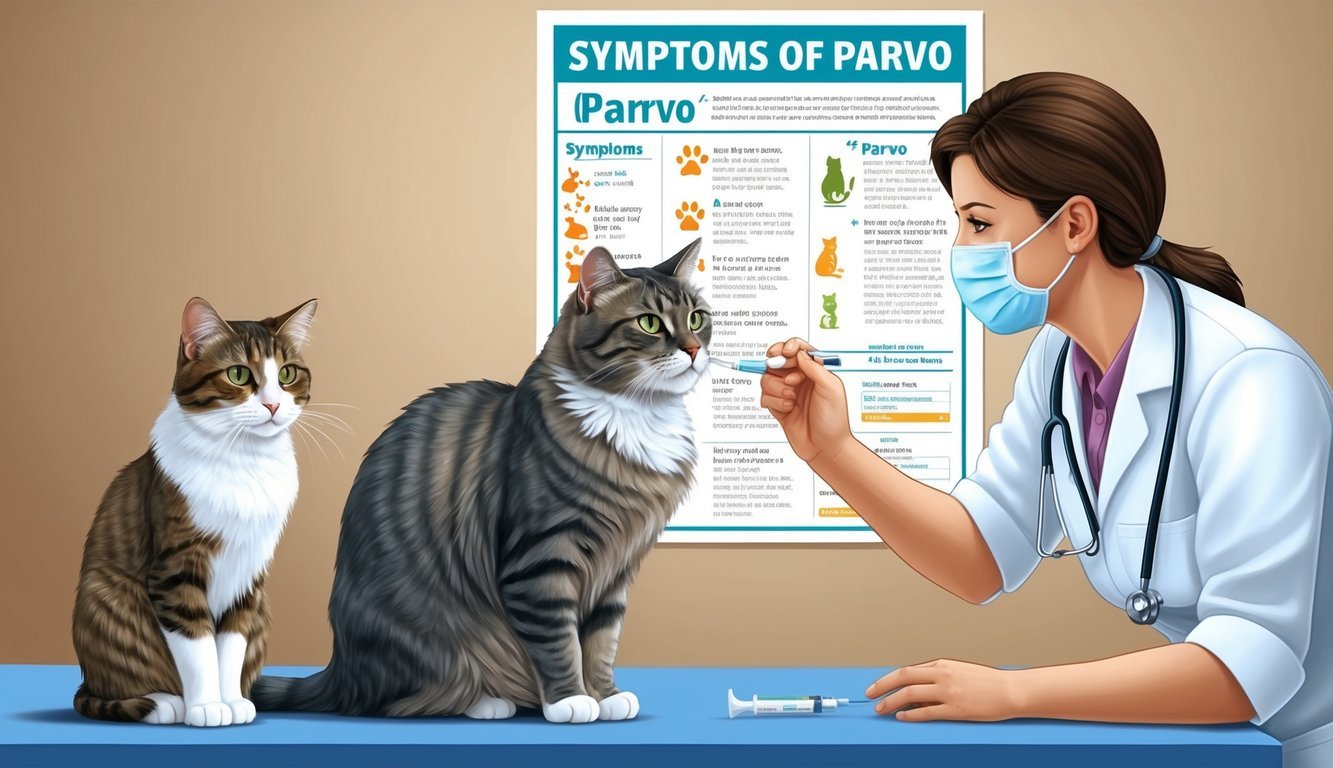
Keeping your cat safe from parvo, or feline panleukopenia, is crucial.
Vaccination plays an essential role in preventing this serious virus, especially for young kittens who are particularly vulnerable.
Here’s what you need to know.
Importance of Vaccination
Vaccination is vital to protect your cat’s health.
The vaccine helps to stimulate the immune system, equipping it to fight off the feline parvovirus.
Unvaccinated cats are at a higher risk of contracting the virus, which can lead to severe illness and even death.
Kittens are especially susceptible, as their immune systems are not fully developed.
A simple shot can make a difference.
Vaccination not only protects your pet but also helps control outbreaks in communities, especially in multi-cat households like shelters and breeders.
Vaccine Schedule
Introducing your kitten to vaccination early in life is crucial.
The recommended vaccination schedule typically begins at 6 to 8 weeks of age.
Here’s a general timeline:
- Initial Vaccination: 6-8 weeks
- Second Dose: 10-12 weeks
- Third Dose: 14-16 weeks
Following this initial series, your cat should receive a booster dose at around one year of age.
This timeline may vary based on your veterinarian’s recommendation and your cat’s specific needs, so always consult with them for an individualized plan.
Boosters and Revaccination
After the initial vaccination series, it’s essential to keep your cat’s immunity up-to-date with regular boosters.
A booster dose typically occurs every one to three years, depending on the vaccine used.
Monitoring your cat’s vaccination status is key, as maintaining immunity is vital for protection against parvovirus.
If a cat is ever off the vaccination schedule, revaccination can restore their immunity.
Always discuss your cat’s specific needs with your veterinarian to ensure they remain healthy and protected.
Understanding Risk Factors
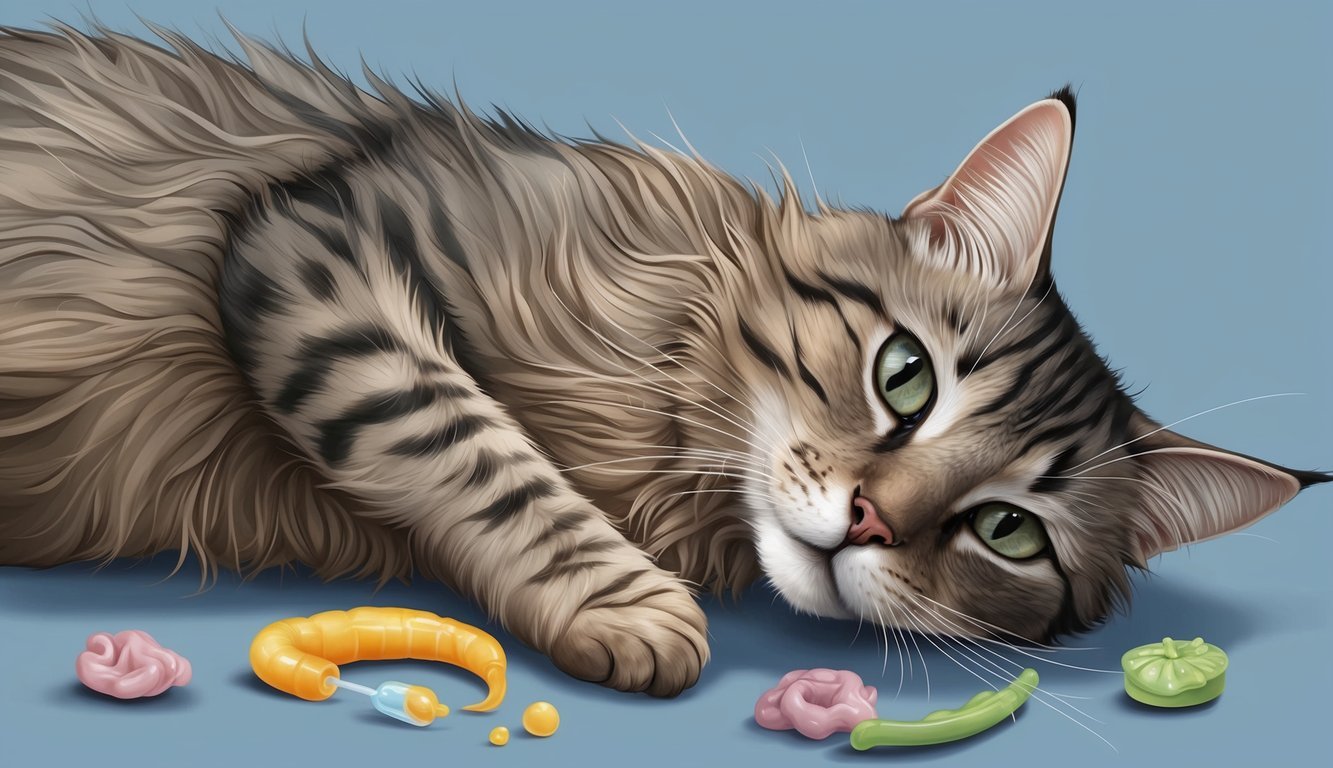
Several factors can increase the likelihood of your cat contracting parvovirus.
You must consider both age and environment when thinking about your cat’s exposure to this serious illness.
Age Susceptibility in Kittens
Kittens are particularly vulnerable to feline parvovirus.
Their immune systems are still developing, which makes them less equipped to fight off infections.
Typically, kittens between the ages of 6 weeks and 6 months face the highest risk.
For optimal protection, ensure your kitten receives a full series of vaccinations. Vaccination typically starts around 6-8 weeks of age, with boosters every few weeks until they reach about 16 weeks.
If your kitten hasn’t completed its vaccination schedule, keep them away from potentially infected cats and environments.
High-Risk Environments
Certain locations pose higher risks for your cat regarding parvovirus. Animal shelters, pet shops, and areas with many cats can be breeding grounds for the virus.
These environments often have multiple animals in close quarters, increasing the chances of virus transmission.
To minimize risk, avoid places where you think many cats congregate, especially if their vaccination status is unknown.
If you must visit such areas, practice good hygiene, like washing your hands before and after contact with any animals. Disinfecting your home and belongings can also help keep the virus at bay.
Supporting Your Cat’s Health Post-Infection
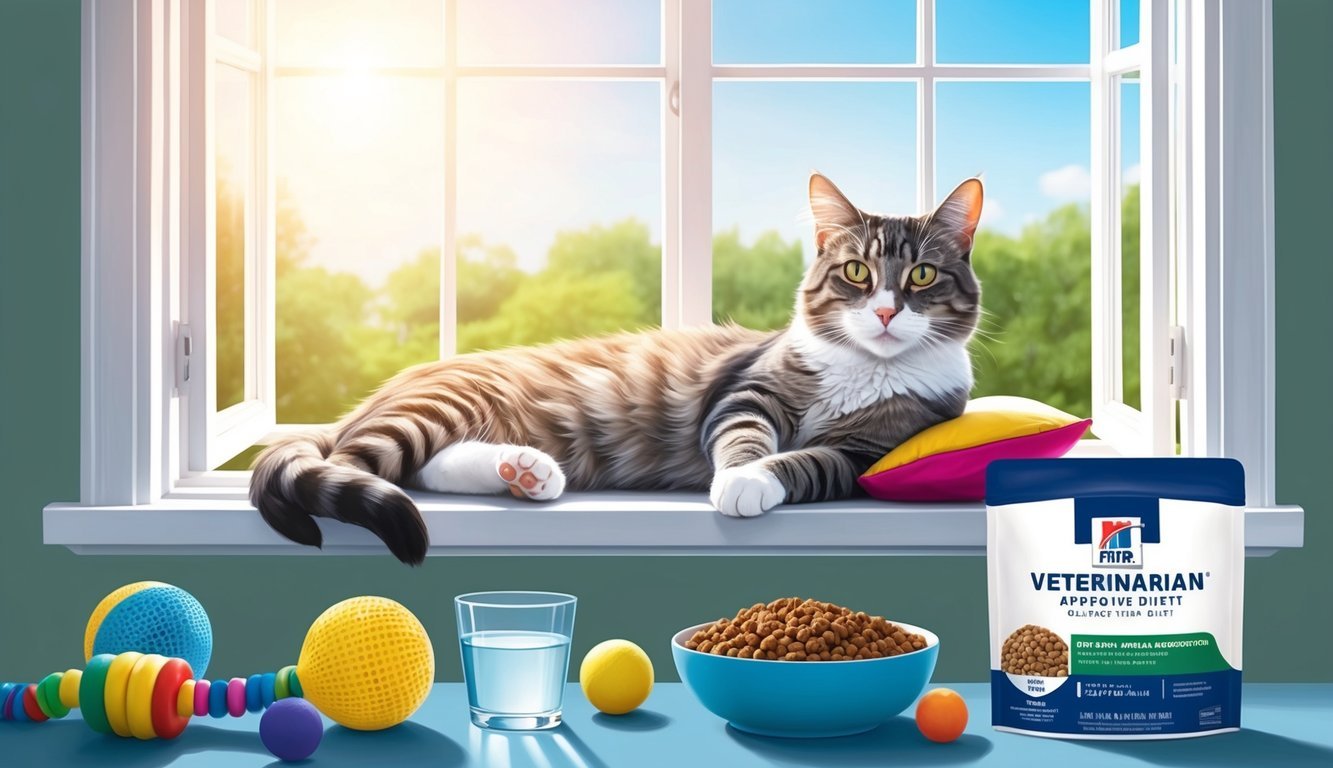
After your cat has battled parvovirus, supporting their recovery is crucial.
Focus on boosting their immune system and ensuring proper care.
Nutritional Support
- Offer an easily digestible diet.
- Include high-quality, nutrient-rich options.
- Consider wet food to keep them hydrated.
Hydration
- Ensure your cat has access to fresh water.
- Monitor for signs of dehydration, like dry gums or lethargy.
Rest and Comfort
- Create a quiet, comfortable resting space.
- Allow your cat to dictate their activity level; they may need more sleep.
Regular Vet Check-ups
- Schedule follow-up appointments with your vet.
- Keep an eye on any lingering symptoms or changes in behavior.
Monitor Behavior and Health
- Observe for signs of improvement or decline.
- Note any changes in appetite, energy, or litter box habits.
Emotional Support
- Spend quality time with your cat to boost their mood.
- Gentle petting and soft speaking can offer reassurance.
Engaging in supportive care will help your cat regain their strength and health.
Stay attentive to their needs and keep in touch with your veterinarian as they recover.
Myths and Misconceptions
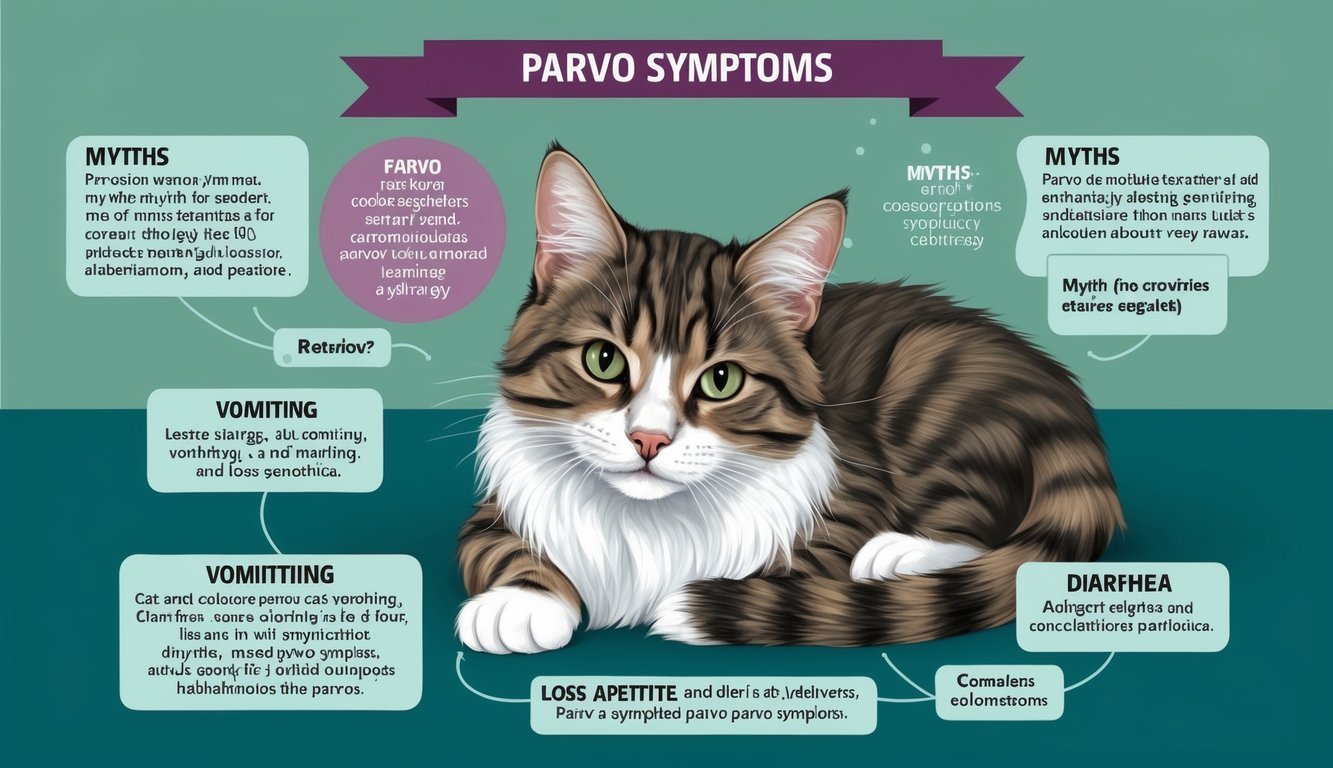
When it comes to parvo in cats, many myths can lead to confusion.
Let’s clear some of them up.
Myth 1: Cats can catch parvo from dogs.
This is not accurate.
Feline parvovirus (often called cat parvo) is different from canine parvovirus.
Your cat cannot get parvo from dogs.
Myth 2: Parvo in cats is the same as in dogs.
Feline parvovirus and canine parvovirus are distinct.
The symptoms and effects of these viruses differ significantly.
Myth 3: All parvo strains affect both cats and dogs.
Not true! Only their respective species are affected by their specific strains.
Feline parvovirus primarily impacts cats, while canine parvovirus targets dogs.
Myth 4: Vaccination guarantees protection.
While vaccination is crucial, it can’t ensure 100% immunity.
Adult cats can still contract feline parvovirus if they haven’t been exposed previously or if they are unvaccinated.
Myth 5: Feline herpesvirus and feline calicivirus are the same as feline parvovirus.
These viruses cause different diseases.
Feline herpesvirus and calicivirus lead to respiratory issues, while parvovirus can cause severe gastrointestinal problems.
By addressing these myths, you can better understand the risks and realities of feline parvovirus.
Staying informed helps in keeping your cat healthy and safe.
Frequently Asked Questions

Understanding parvo can be crucial for your cat’s health.
Here are some common questions about the symptoms and risks associated with feline parvovirus.
How can I identify the stages of parvo in my cat?
Feline parvovirus progresses through distinct stages.
Initially, you may notice subtle changes, such as lethargy and decreased appetite.
As the infection advances, symptoms like vomiting, diarrhea, and fever become prominent.
What are the early signs that might indicate my cat has parvo?
Early signs often include lethargy, fever, and a sudden loss of appetite.
You may also see vomiting or a watery discharge from the nose as the virus begins to take effect.
Is it possible for my cat to contract parvo from a dog?
No, feline parvovirus specifically affects cats.
While dogs can contract their own version of parvo, known as canine parvovirus, the strains are different, and cross-infection does not occur.
What should I observe if I suspect my cat has parvo-related diarrhea?
If your cat has diarrhea that is watery or bloody, it’s crucial to monitor its severity.
Keep an eye on other symptoms such as vomiting or lethargy, which can indicate the progression of the disease.
Can a cat survive after being infected with parvo, and what are the chances?
Survival rates largely depend on the severity of the infection and the timeliness of treatment.
With prompt veterinary care, many cats can recover, although young kittens are at higher risk.
Are humans at risk of catching parvo from their feline companions?
No, cats cannot transmit feline parvovirus to humans.
The virus is species-specific and poses no risk to human health.

